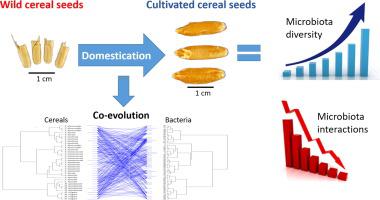Journal of Advanced Research ( IF 10.7 ) Pub Date : 2020-12-17 , DOI: 10.1016/j.jare.2020.12.008 Yulduzkhon Abdullaeva 1 , Binoy Ambika Manirajan 1 , Bernd Honermeier 2 , Sylvia Schnell 1 , Massimiliano Cardinale 1, 3

|
Introduction
The seed-associated microbiome has a strong influence on plant ecology, fitness, and productivity. Plant microbiota could be exploited for a more responsible crop management in sustainable agriculture. However, the relationships between seed microbiota and hosts related to the changes from ancestor species to breeded crops still remain poor understood.
Objectives
Our aims were i) to understand the effect of cereal domestication on seed endophytes in terms of diversity, structure and co-occurrence, by comparing four cereal crops and the respective ancestor species; ii) to test the phylogenetic coherence between cereals and their seed microbiota (clue of co-evolution).
Methods
We investigated the seed microbiota of four cereal crops (Triticum aestivum, Triticum monococcum, Triticum durum, and Hordeum vulgare), along with their respective ancestors (Aegilops tauschii, Triticum baeoticum, Triticum dicoccoides, and Hordeum spontaneum, respectively) using 16S rRNA gene metabarcoding, Randomly Amplified Polymorphic DNA (RAPD) profiling of host plants and co-evolution analysis.
Results
The diversity of seed microbiota was generally higher in cultivated cereals than in wild ancestors, suggesting that domestication lead to a bacterial diversification. On the other hand, more microbe-microbe interactions were detected in wild species, indicating a better-structured, mature community. Typical human-associated taxa, such as Cutibacterium, dominated in cultivated cereals, suggesting an interkingdom transfers of microbes from human to plants during domestication. Co-evolution analysis revealed a significant phylogenetic congruence between seed endophytes and host plants, indicating clues of co-evolution between hosts and seed-associated microbes during domestication.
Conclusion
This study demonstrates a diversification of the seed microbiome as a consequence of domestication, and provides clues of co-evolution between cereals and their seed microbiota. This knowledge is useful to develop effective strategies of microbiome exploitation for sustainable agriculture.
中文翻译:

驯化影响谷物种子微生物群的组成、多样性和共存
介绍
种子相关微生物组对植物生态、适应性和生产力有很大影响。可以利用植物微生物群在可持续农业中进行更负责任的作物管理。然而,与从祖先物种到育种作物的变化相关的种子微生物群与宿主之间的关系仍然知之甚少。
目标
我们的目标是 i) 通过比较四种谷类作物和各自的祖先物种,了解谷类驯化对种子内生菌的多样性、结构和共生性的影响;ii) 测试谷物与其种子微生物群之间的系统发育一致性(共同进化的线索)。
方法
我们研究了四个谷类作物种子微生物群(普通小麦,一粒小麦,硬粒小麦,和大麦),以及它们相应的祖先(节节麦,小麦baeoticum,野生二粒小麦,和大麦根子使用16S rRNA基因metabarcoding,分别地) , 宿主植物的随机扩增多态性 DNA (RAPD) 分析和共同进化分析。
结果
栽培谷物中种子微生物群的多样性通常高于野生祖先,这表明驯化导致细菌多样化。另一方面,在野生物种中检测到更多的微生物-微生物相互作用,表明群落结构更好、更成熟。典型的人类相关分类群,如角质杆菌,在栽培谷物中占主导地位,表明在驯化过程中微生物从人类到植物的界际转移。共同进化分析揭示了种子内生菌和宿主植物之间显着的系统发育一致性,表明在驯化过程中宿主与种子相关微生物之间的共同进化线索。
结论
这项研究证明了驯化后种子微生物群的多样化,并提供了谷物与其种子微生物群共同进化的线索。这些知识有助于制定可持续农业微生物组开发的有效策略。


























 京公网安备 11010802027423号
京公网安备 11010802027423号